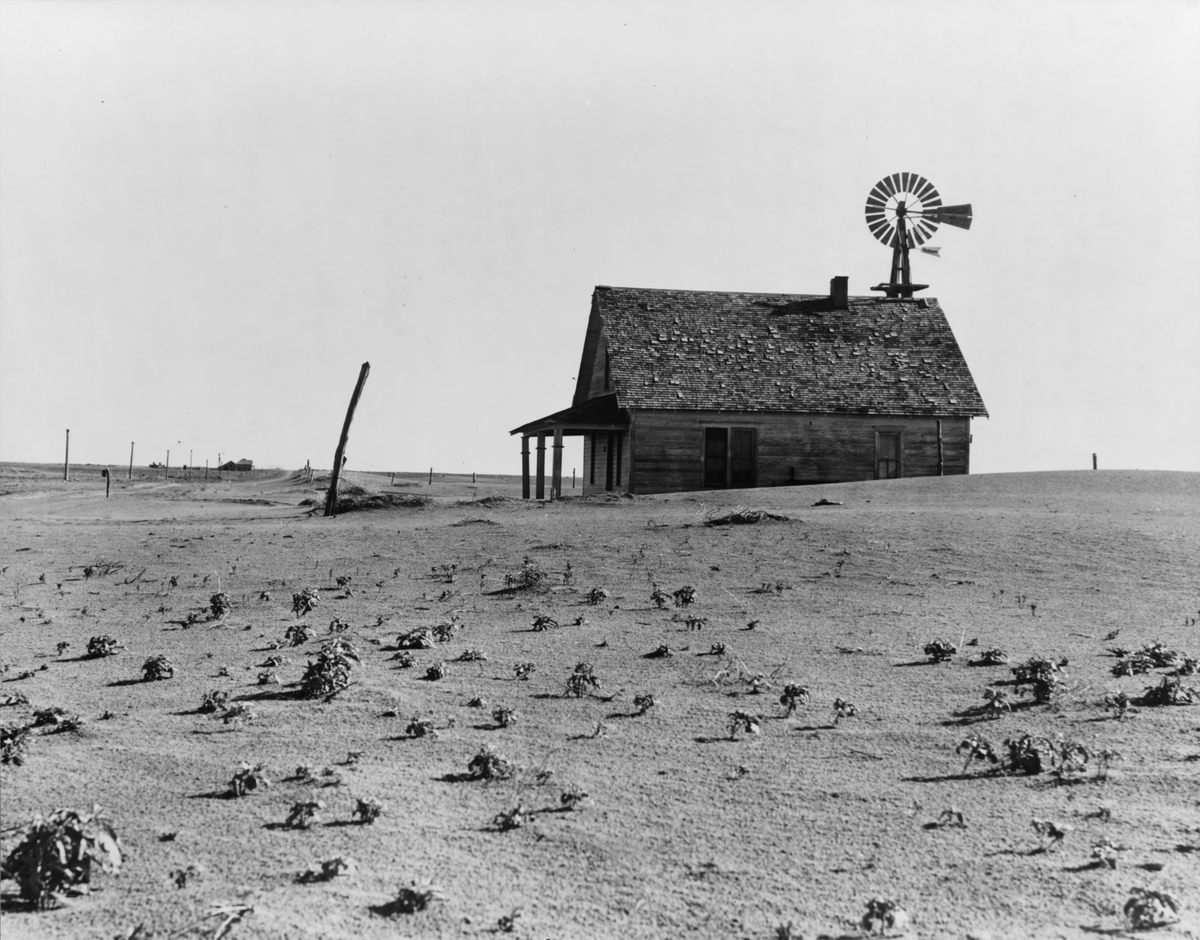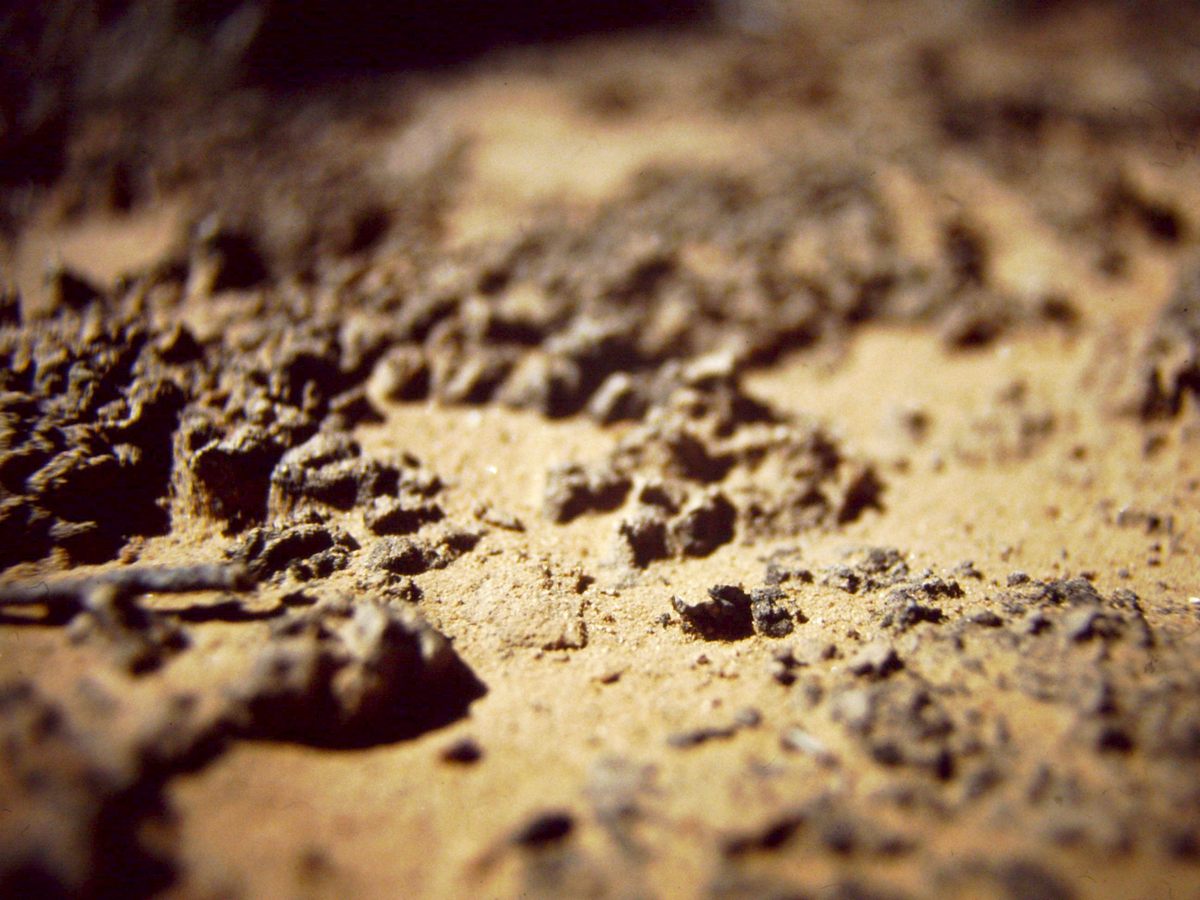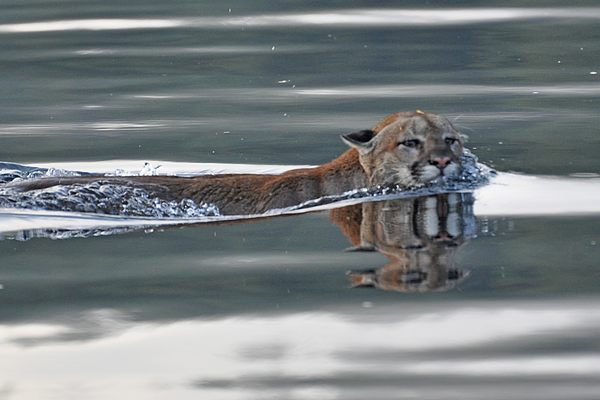
By Air, Land, or Sea, Tiny Microbes Transform Our World
They often get a bad rap, but bacteria prevent erosion, undergird ecosystems, and make artificial snow.
Excerpted and adapted with permission from Slime: A Natural History, by Susanne Wedlich. Published February 2023 by Melville House. All rights reserved.
A haboob is a dust storm. It’s an Arabic word for a phenomenon that struck the American Midwest like a plague of biblical proportions just under a century ago. This storm was not the work of God’s chastising hand, though; it was the worst man-made environmental catastrophe the United States has ever seen. East of the Rocky Mountains, the Great Plains extend like wide corridors all the way from Mexico to Canada. The land is dry and naturally covered by a community of robust plant life—primarily prairie grasses—whose dense root networks stabilize the soil beneath. But then the humans came. The government knew the plains were not arable land and that, at best, only large farms with complex irrigation systems might be able to make a living there. Little family farms without adequate capital, however, would not be able to survive.
Nevertheless, the land was advertised intensively into the 1930s and allocated to settlers free of charge as fertile land requiring little more than a “tickle” with the plow to unleash its productivity. The railways, needing to pay off their newly laid network of tracks, joined in the propaganda for the “Nile of the New World.” In the decades to come, around a third of the Great Plains would be transformed into green grassland and pastures, worked intensively with horse and plow, which disturbed the dense root network of the original plant life. As we now know, essential biological glues were lost.
Another of the government’s promises was that the rains would follow the plow, but what actually followed was, in essence, the apocalypse. The exposed earth grew drier and hotter, losing its stability, and became subject to droughts and erosion. This was followed by a rare weather phenomenon, reversing the jet stream which usually carried clouds and rain towards the Midwest. Now the rains stayed away, the harvests withered and vast clouds of dust loomed like a black rock face, kilometers high. In 1933 alone there were more than 50 haboobs, which swept across the landscape.
Images from this period show houses and farms submerged as if beneath a gray flood, waves of dust and earth washing as high as their roofs. Contemporary witnesses spoke of fine grains grating against the skin like sandpaper, blinding people, suffocating cattle and leaving children sick with the “brown plague,” a type of pneumonia caused by dust, as described by Timothy Egan in his award-winning book The Worst Hard Time. There was no escape. In the evenings, families sealed their windows and doors with damp towels, yet they would still find themselves shoveling dust out of their homes and cottages come morning.

The dust in the air muffled the voices of crowing cockerels and the sun hung blood-red in the sky. By afternoon it would be dark again, and anyone out and about in the dense haze would tie a rope around their middle so as to be able to find their way back. The dust was carried from the Great Plains as far as Chicago, and all the way to the Capitol in Washington, D.C. It left a brown coating even on ships at sea. April 14, 1935, “Black Sunday,” brought the mother of all haboobs, during which, according to Egan, twice the amount of dust went swirling across the country in a single afternoon as had been dug up over seven years to build the Panama Canal.
For most farmers, there was no longer a possibility of making a living in the Midwest. The photographer Dorothea Lange became famous for her portraits of careworn and gaunt migrants and their rag-clad children making their way westwards. Like the Joad family in Steinbeck’s masterpiece The Grapes of Wrath, they were following another empty promise, that there would be work in the big cities of California and elsewhere, a promise thwarted by the global economic crisis which shook the 1930s. Those who stayed behind had little more luck, as the meager harvests were destroyed by devastating blights and, in any case, the land did not recover from the destruction it had suffered.
The consequences are not always so catastrophic when dry soil loses its stability and is exposed to erosion. But even little changes can jeopardize our food supply if they occur on a sufficiently vast scale: if, for example, entire areas of land are exposed to higher temperatures and lower levels of precipitation due to climate change. Most at risk here are the biological soil crusts, ecological communities often unseen or mere millimeters tall which cover the ground in deserts and dry regions, but are also capable of growing on and underneath stones.
Where and whether they form depends on precipitation, temperature, and the agricultural use of the land. They are particularly prevalent in deserts, as well as steppes and savannas, especially in southern Africa, Australia, and Asia, and in the American Southwest. They are seldom found in temperate zones, such as those in Central Europe, where vascular plants like shrubs and trees completely cover the ground. According to a study by the Max Planck Institute for Chemistry in Mainz, led by Bettina Weber, biological soil crusts cover up to 12 percent of Earth’s surface, corresponding to 40 percent of actual land mass.
Biological soil crusts are Earth’s living skin, a protective barrier. Yet they also accumulate and transform nutrients and play a key role in larger biogeochemical processes, such as the global nitrogen and carbon cycles. “Earth’s crusts are dry, hard, and, well, crusty,” says Weber, “but there’s also a certain sliminess.” Cyanobacteria are pioneers of soil crusts, setting things in motion by secreting exopolymers which will build a slimy matrix. It’s sticky enough to glue particles in the soil together, protecting it from erosion. This hydrogel also binds and stores the small amount of water that is present—for example, after rain—before it evaporates or trickles away.
Biological soil crusts are complex ecological communities which science categorizes according to their developmental stages. Cyanobacteria are the vanguard, paving the way for other microbes like bacteria, as well as archaea or fungi, which join the young community, doing their part by breaking down organic matter. These might be followed by lichen and mosses, possibly even by worms, slugs, snails, or springtails, and other arthropods as well. It can take years or even decades for a soil crust to become this diverse, potentially boasting many hundreds of different species.

However, there are differences between these communities in the crust, not only in regard to the level of maturity they achieve over time, but spatially too: Soil crusts are separated into layers. Strongly pigmented fungi and all photosynthesizing organisms, such as cyanobacteria, generally colonize the top layer because they require and can tolerate UV radiation, while shadier characters live lower down in the ecosystem. They must all be able to survive long periods of drought. Specialists in this area include, for example, the tardigrade, which can enter a state of dormancy before quickly reactivating as soon as water is available.
These days, however, biological soil crusts are under threat. According to Weber’s calculations, up to a quarter of this protective coating could soon disappear. Climate change is as much a factor as population growth, which requires the expansion of arable land to include dry and previously unused strips, hitherto covered by biological soil crusts. This development could have consequences across the globe, affecting the nitrogen cycle, among other things.
Nitrogen is present in the ground and the atmosphere but cannot be taken up directly by plants. Plants rely on soil microbes which fix nitrogen, making it available for plants to use. Weber has calculated that as much as half of this essential service may be provided by soil crusts.
Disturbances to the structure would hit many ecosystems in nutrient-poor regions particularly hard. But the loss of the soil crusts would also expose the ground to intensified erosion by water and wind, enriching the atmosphere with the tiniest of particles. It doesn’t need another dust bowl like that of the Great Plains in the 1930s to pose a risk to human health, and not just for people with allergies and hay fever.
The notion of miasmas transmitting fatal infections such as malaria (from mal aria, bad air) has been put to bed. Yet the air around us is filled with microbes, pollen, and other particles which have the potential to cause us harm. The great microbiologist Louis Pasteur was the first to prove that open wounds could be infected with germs from the air. In a sense, this made him the founder of aerobiology, a discipline which witnessed its first and—to date—last golden age in the 1930s, when farmers in the Midwest were facing a global financial crisis, devastating haboobs, and plant pathogens thrown in for good measure.
Fred C. Meier of the U.S. Department of Agriculture happened to be the right person in the right place at the right time. A tremendously charismatic man with a pilot’s license, he hoped to discover how the deadly rust fungus—or its spores—was spreading, and to what extent weather and the atmosphere were contributing factors. To this end he recruited American aviation’s shining stars, including Amelia Earhart. She was joined in her aerobiological efforts by a celebrity couple, the Lindberghs. Charles Lindbergh’s pioneering flight across the Atlantic overshadowed his wife’s success somewhat, though Anne Lindbergh was one of the first female pilots in the U.S. and steered the plane on their joint flights as well.
In 1933, the couple flew from the U.S., over Greenland, and as far as Denmark. As discussed with Meier beforehand, they used “sky hooks” as airborne traps. Charles had constructed them himself out of a metal cylinder containing oily, sticky glass slides which would catch solid particles in the air. In fact, a kilometer above Greenland they found spores of exactly the same rust and other fungi that were growing on the ground thousands of miles away, causing vast agricultural damage. The findings were clear: These spores were nomads that traveled by air, high up in the planet’s atmosphere. And they were not alone: The Lindberghs also collected grains of pollen, fragments of fungal mycelium, single-celled algae like diatoms, insect wings, volcanic ash, and glass particles in their sealed traps.

Like the microbes of the deep biosphere in Earth’s crust, other bacteria and spores define the limits of life high beyond the clouds. The living inhabitants of the air, which drift with the wind and cannot fly themselves, are sometimes referred to as aeroplankton, inspired by the ecological communities which float through the oceans.
We already know, to some extent, where these airborne microbes come from, or at least where their journey begins. They can find their way from the ocean into the atmosphere when air bubbles rise through the water and burst at its gel-like surface, which is densely populated by microbes.
Even the leaves of plants can be a starting point for propelling matter into the air. Many pathogens that affect humans are transmitted via the air we breathe, or via coughs and sneezes, as the coronavirus pandemic has taught us all too well. This is known as droplet transmission. Lydia Bourouiba at MIT demonstrated that plants spread pathogens in a similar way, with fungi, for example, traveling via spattering droplets of rain. They cover themselves in a slimy coat of mucilage, which protects them and prevents them from being carried high up into the air on the wind. If a raindrop strikes an affected leaf, the water splashes off, carrying the pathogen with it, maybe to its next host.
Pseudomonas syringae is an economically devastating pathogen, infecting hundreds of plant species, which also specializes in life in the air. This bacterium is present across the world, including in water, but can also survive for several days in the atmosphere, where it is thought to live on fragments of plant matter swept up into the air.

Spanish researchers have shown that microbes can travel ensconced in atmospheric dust, even between continents. Their vehicles of choice are iberulites: dust particles made from different minerals that reach considerable size and are glued together by bacterial slime. These kinds of aggregates from mineral and biological components occur all over the world. The ones that were studied in detail this time were found in the city of Granada but held dust grains and microbes from the Sahara. In the atmosphere they had been caught in a water droplet as a bioaerosol and had then taken on the characteristic shape of iberulites, a little like a dented cannonball.
Some strains of P. syringae, however, produce a protein that causes water to freeze at unusually high temperatures. Like other microbes and particles, this bacterium acts as a crystallization point for ice formation. One hypothesis is that P. syringae may be able to return to the ground inside a self-made hailstone or snowflake when conditions at altitude become too uncomfortable. Thanks to its freezing proteins, a harmless version of the pathogen is also used to make artificial snow.
Soils, and especially their biological crusts, are closely tied to aeroplankton, too. And they’re equally threatened by disruption through climate change. The expansion of agriculture is another danger, and even smaller damage can have lasting effects. Shoes, hooves, and tires are capable of destroying these fragile biocrusts, which may take decades to regenerate—if they ever get a chance. To lose them would mean losing what were probably evolution’s first ecological communities. Not only do they occur on all continents and in all climatic zones, but they were probably the first ecosystems to venture onto dry land, forming along the edges of bodies of water before moving further inland. They still play a vital role in shaping the habitat of many other organisms, by fixing nitrogen and binding carbon dioxide from the atmosphere. They are also important for weathering processes, breaking down mineral underlayers.
Since the cyanobacterias’ slimy matrix stores the little water there is, the soil-crust community and higher plants benefit, even on grazing land. Sometimes, however, less is more. The Atacama Desert in Chile is one of the driest places on Earth. Very few bacteria, algae, fungi, and lichen are able to survive here, in the soil crusts or as part of the soil microbiota. When the first rainstorms for decades made their way across this region in 2017—a consequence of climate change—it seemed that the born survivors which inhabit this area would finally be granted a well-deserved embarrassment of liquid riches. In fact, the episode culminated in a microbial massacre as the unprecedented excess of water caused the organisms to burst. Of the microbes which normally occur in and on top of the soil in Atacama, only a handful of species survived.


































Follow us on Twitter to get the latest on the world's hidden wonders.
Like us on Facebook to get the latest on the world's hidden wonders.
Follow us on Twitter Like us on Facebook